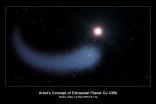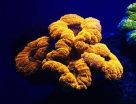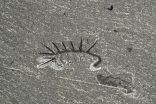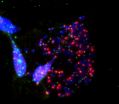(Press-News.org) Astronomers using NASA's Hubble Space Telescope have discovered an immense cloud of hydrogen dubbed "The Behemoth" bleeding from a planet orbiting a nearby star. The enormous, comet-like feature is about 50 times the size of the parent star. The hydrogen is evaporating from a warm, Neptune-sized planet, due to extreme radiation from the star.
This phenomenon has never been seen around an exoplanet so small. It may offer clues to how other planets with hydrogen-enveloped atmospheres could have their outer layers evaporated by their parent star, leaving behind solid, rocky cores. Hot, rocky planets such as these that roughly the size of Earth are known as Hot-Super Earths.
"This cloud is very spectacular, though the evaporation rate does not threaten the planet right now," explains the study's leader, David Ehrenreich of the Observatory of the University of Geneva in Switzerland. "But we know that in the past, the star, which is a faint red dwarf, was more active. This means that the planet evaporated faster during its first billion years of existence because of the strong radiation from the young star. Overall, we estimate that it may have lost up to 10 percent of its atmosphere over the past several billion years."
The planet, named GJ 436b, is considered to be a "Warm Neptune," because of its size and because it is much closer to its star than Neptune is to our sun. Although it is in no danger of having its atmosphere completely evaporated and stripped down to a rocky core, this planet could explain the existence of so-called Hot Super-Earths that are very close to their stars.
These hot, rocky worlds were discovered by the Convection Rotation and Planetary Transits (CoRoT) and NASA's Kepler space telescope. Hot Super-Earths could be the remnants of more massive planets that completely lost their thick, gaseous atmospheres to the same type of evaporation.
Because the Earth's atmosphere blocks most ultraviolet light, astronomers needed a space telescope with Hubble's ultraviolet capability and exquisite precision to find "The Behemoth."
"You would have to have Hubble's eyes," says Ehrenreich. "You would not see it in visible wavelengths. But when you turn the ultraviolet eye of Hubble onto the system, it's really kind of a transformation, because the planet turns into a monstrous thing."
Because the planet's orbit is tilted nearly edge-on to our view from Earth, the planet can be seen passing in front of its star. Astronomers also saw the star eclipsed by "The Behemoth" hydrogen cloud around the planet.
Ehrenreich and his team think that such a huge cloud of gas can exist around this planet because the cloud is not rapidly heated and swept away by the radiation pressure from the relatively cool red dwarf star. This allows the cloud to stick around for a longer time. The team's findings will be published in the June 25 edition of the journal Nature.
Evaporation such as this may have happened in the earlier stages of our own solar system, when the Earth had a hydrogen-rich atmosphere that dissipated over 100 to 500 million years. If so, the Earth may previously have sported a comet-like tail.
GJ 436b resides very close to its star - less than 2 million miles -- and whips around it in just 2.6 Earth days. In comparison, the Earth is 93 million miles from our sun and orbits it every 365.24 days. This exoplanet is at least 6 billion years old, and may even be twice that age. It has a mass of around 23 Earths. At just 30 light-years from Earth, it's one of the closest known extrasolar planets.
Finding "The Behemoth" could be a game-changer for characterizing atmospheres of the whole population of Neptune-sized planets and Super-Earths in ultraviolet observations. In the coming years, Ehrenreich expects that astronomers will find thousands of this kind of planet.
The ultraviolet technique used in this study also may also spot the signature of oceans evaporating on smaller, more Earth-like planets. It will be extremely challenging for astronomers to directly see water vapor on those worlds, because it's too low in the atmosphere and shielded from telescopes. However, when water molecules are broken by the stellar radiation into hydrogen and oxygen, the relatively light hydrogen atoms can escape the planet. If scientists spot this hydrogen evaporating from a planet that is slightly more temperate and less massive than GJ 436b, it could be an indication of an ocean on the surface.
INFORMATION:
The Hubble Space Telescope is a project of international cooperation between NASA and the European Space Agency. NASA's Goddard Space Flight Center in Greenbelt, Maryland, manages the telescope. The Space Telescope Science Institute (STScI) in Baltimore conducts Hubble science operations. STScI is operated for NASA by the Association of Universities for Research in Astronomy, in Washington.
For images and more information about Hubble, visit:
http://www.nasa.gov/hubble
hubblesite.org/news/2015/17
Cystic fibrosis is more deadly for Hispanic than non-Hispanic patients, a disparity that is not explained by differences in their access to health care, according to a new study from the Stanford University School of Medicine.
The study, published online June 18 in Chest, tracked more than 1,700 California residents with cystic fibrosis. Between 1991 and 2010, Hispanic CF patients were almost three times as likely to die as non-Hispanic CF patients, the study found. The gap in survival existed in spite of the fact that both groups visited CF specialty clinics equally ...
Glowing corals that display a surprising array of colours have been discovered in the deep water reefs of the Red Sea by scientists from the University of Southampton, UK, Tel Aviv University and the Interuniversity Institute for Marine Sciences (IUI), Israel, together with an international team of researchers.
The researchers, whose findings have been published online today in research journal PLOS ONE, hope that some of the coral pigments could be developed into new imaging tools for medical applications.
The team studied corals at depths of more than 50 metres and ...
Vitamin B12 tweaks how genes behave in the facial bacteria of some people who normally enjoy clear skin. The activity changes of the facial bacteria promote inflammation and lead to pimples.
By shedding light on one mechanism behind B12's role in acne, the UCLA finding may identify drug targets that lead to new treatments for acne.
Huiying Li, an assistant professor of molecular and medical pharmacology at the David Geffen School of Medicine at UCLA, and Dr. Noah Craft, a dermatologist at LA BioMed at Harbor-UCLA Medical Center, are available for interviews.
Science ...
On the hunt for better cancer screening tests, Johns Hopkins scientists led a proof of principle study that successfully identified tumor DNA shed into the blood and saliva of 93 patients with head and neck cancer. A report on the findings is published in the June 24 issue of Science Translational Medicine.
"We have shown that tumor DNA in the blood or saliva can successfully be measured for these cancers," says Nishant Agrawal, M.D., associate professor of otolaryngology -- head and neck surgery -- and of oncology at the Johns Hopkins University School of Medicine. "In ...
Various diagnostic imaging techniques are currently used for clinical imaging/disease diagnosis. The accuracy of diagnosis is mainly based on the type of energy used (such as X-ray, sound waves, photons and positrons) to derive the visual information, as well as the degree of spatial resolution (mesoscopic or microscopic) and the level of information that can be obtained (physiological, anatomical or molecular). Based on potential health hazards imposed by type of energy used, clinical imaging modalities can be broadly categorized as ionizing and non-ionizing modalities. ...
From AGU's blogs: Landslide-induced sediment production after the Sabah earthquake in Malaysia
The Mw=6.0 5 June 2015 Sabah earthquake in Malaysia, which killed 18 people in rockfalls on Mount Kinabalu, generated landslides that have released large volumes of sediment. The heavy tropical rainfall in Sabah means that this sediment is now starting to enter the river systems in the form of mudflows and sediment-rich flash floods. Dave Petley explores the aftermath of the Sabah earthquake in a new post on The Landslide Blog.
From Eos.org: Improving predictions of Arctic ...
A new study of an otherworldly creature from half a billion years ago - a worm-like animal with legs, spikes and a head difficult to distinguish from its tail - has definitively identified its head for the first time, and revealed a previously unknown ring of teeth and a pair of simple eyes. The results, published today in the journal Nature, have helped scientists reconstruct what the common ancestor of everything from tiny roundworms to huge lobsters might have looked like.
Researchers from the University of Cambridge, the Royal Ontario Museum and the University of ...
LA JOLLA--Telomeres, specialized ends of our chromosomes that dictate how long cells can continue to duplicate themselves, have long been studied for their links to the aging process and cancer. Now, a discovery at the Salk Institute shows that telomeres may be more central than previously thought to a self-destruct program in cells that prevents tumors, a function that could potentially be exploited to improve cancer therapies.
When cells replicate in a process called mitosis, their telomeres get a little shorter each time. Eventually, after many cell divisions, telomeres ...
The prospect of finding ocean-bearing exoplanets has been boosted, thanks to a pioneering new study.
An international team of scientists, including from the University of Exeter, has discovered an immense cloud of hydrogen escaping from a Neptune-sized exoplanet.
Such a phenomena not only helps explain the formation of hot and rocky 'super-earths', but also may potentially act as a signal for detecting extrasolar oceans. Scientists also believe they can use the discovery to envisage the future of Earth's atmosphere, four billion years from today.
The ground-breaking ...
DETROIT - Urban gardens are becoming more commonplace across Detroit and other major urban cities throughout the United States. These gardens offer a source of free or inexpensive healthy food for the public and educate community members about food production and rehabilitating the local ecosystem. The revolution of urban agriculture has the potential to address many economic, environmental and personal health issues.
With urban agriculture gaining popularity for improving local and sustainable food systems, the question of food safety has become a growing concern. To ...




